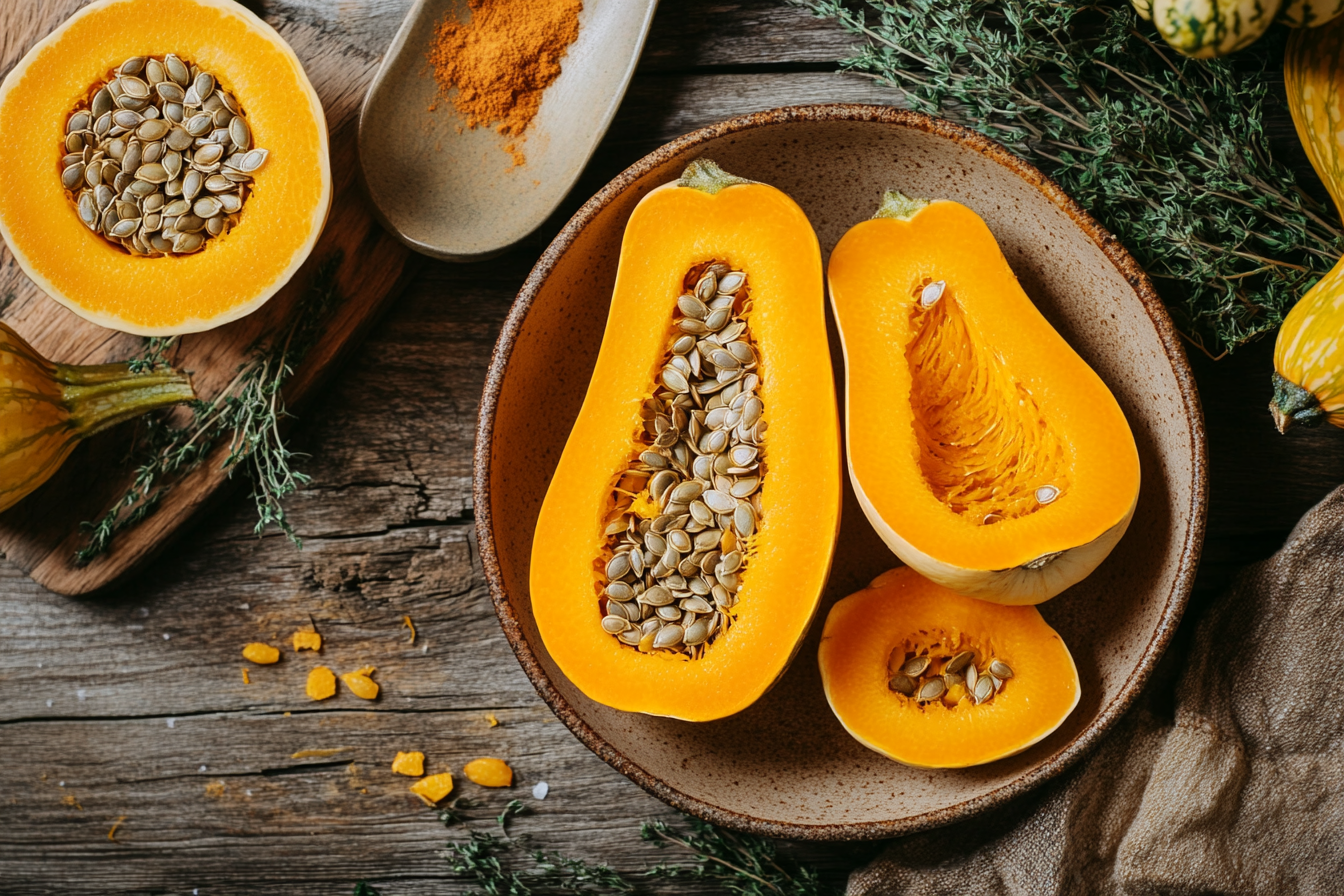In this guide, we’ll cover whether you can eat them, how to grow them, and what to do with the seeds from butternut squash. You’ll also learn whether soaking is really needed before planting. If you love finding practical ways to use every part of your food, this one’s for you.
Let’s start with the story behind the seeds that became a pantry and garden staple in my Dubai kitchen.
Table of Contents
Table of Contents
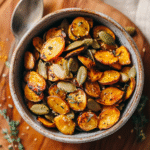
Squash Butternut Seeds: Smart Ways to Eat, Plant & Enjoy This Seasonal Superfood
- Total Time: 30 mins
- Yield: 1 cup
- Diet: Vegan
Description
These roasted squash butternut seeds are crispy, flavorful, and perfect as a healthy snack or salad topper.
Ingredients
1 cup fresh squash butternut seeds
1 tbsp olive oil
1/2 tsp sea salt
1/2 tsp paprika (or any seasoning of choice)
Instructions
1. Preheat oven to 350°F (175°C).
2. Clean and dry squash butternut seeds.
3. Toss with olive oil, salt, and spices.
4. Spread on a baking tray.
5. Roast for 15–20 minutes, stirring halfway.
6. Cool and store in an airtight jar.
Notes
You can use cinnamon sugar or za’atar for a sweet or savory twist. For planting, save raw seeds and dry them fully.
- Prep Time: 10 mins
- Cook Time: 20 mins
- Category: Snacks
- Method: Roasting
- Cuisine: American
Nutrition
- Serving Size: 2 tbsp
- Calories: 90
- Sugar: 0g
- Sodium: 80mg
- Fat: 6g
- Saturated Fat: 1g
- Unsaturated Fat: 4.5g
- Trans Fat: 0g
- Carbohydrates: 3g
- Fiber: 1g
- Protein: 3g
- Cholesterol: 0mg
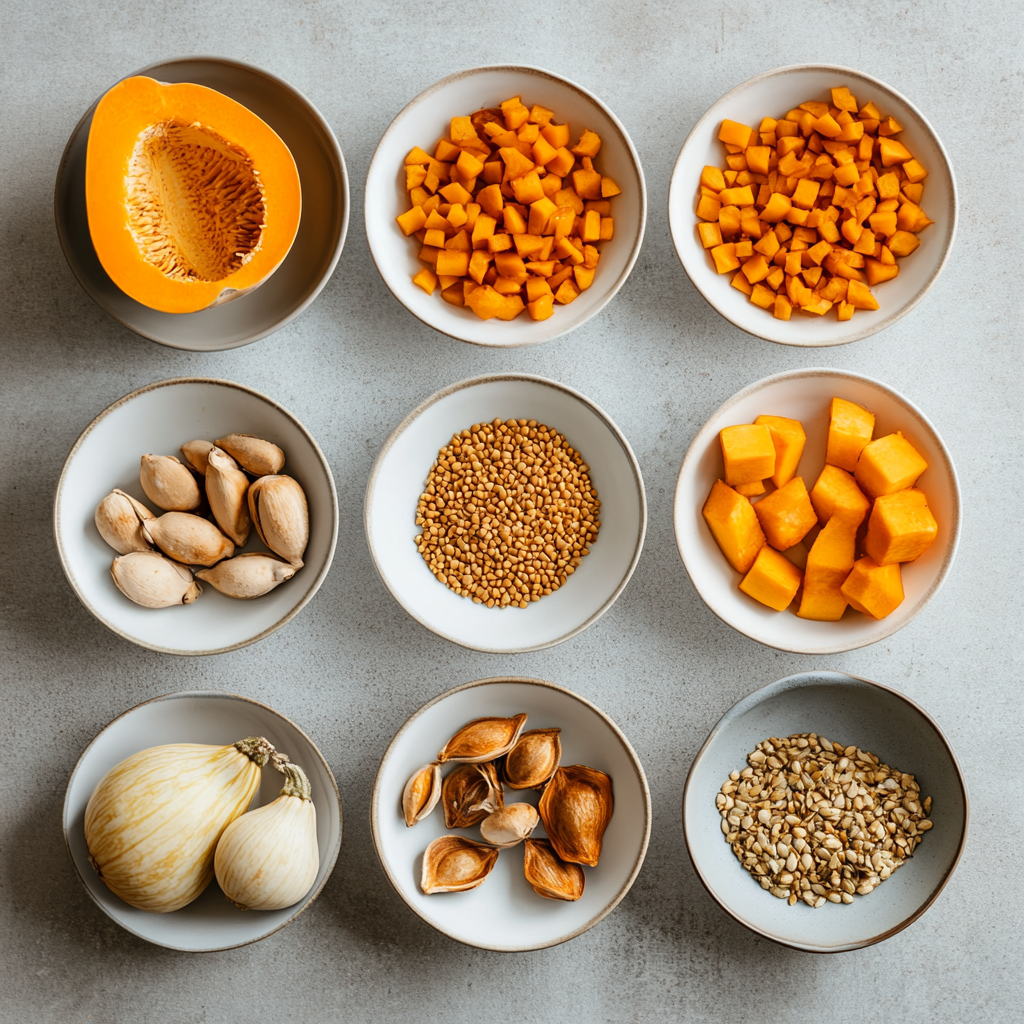
The Story & Intro: Why I Never Throw Out Squash Butternut Seeds
Growing up in Vermont, I learned early that fall meant two things: crispy leaves and warm bowls of roasted butternut squash soup. Back then, my grandma used to scoop the seeds into the compost—until one day she roasted them by mistake (thinking they were pumpkin seeds). That happy accident turned into a family ritual.
Years later, living in Dubai, I kept that tradition alive in my own kitchen. Here, butternut squash is available nearly year-round, and I love pairing its sweetness with spices like za’atar or sumac. But what truly surprised me? How often people toss the seeds! Squash butternut seeds aren’t just edible—they’re nutritious, tasty, and perfect for planting too. I’ve even helped a neighbor grow her first batch of squash just using leftover seeds from my soup prep.
That’s the kind of small joy I live for. If you’re wondering whether to eat them, plant them, or both—don’t worry. This article will walk you through every option with easy, real-life tips.
You’ll also find answers to the most common questions like: Can I grow butternut squash from seeds? Do I need to soak them before planting? We’ll cover it all.
And if you’re into clean eating, you’ll love how squash seeds pair with ideas from gluten dairy sugar free dessert recipes.
Are You Supposed to Eat the Seeds in Butternut Squash?
Yes, absolutely. Squash butternut seeds are 100% edible. Just clean, dry, toss in oil, season with sea salt, cinnamon, or paprika, and roast at 350°F for about 15–20 minutes. They’re perfect on salads, yogurt bowls, or just straight from the jar.
Even better? They’re packed with zinc, healthy fats, and protein. A tablespoon of roasted seeds can provide a quick energy boost without processed ingredients. For women looking for snack alternatives, these seeds are a great replacement for chips or crackers.
I often pair mine with lemon balm recipes or sprinkle them over savory baked dishes to add crunch.The Best Way to Clean and Prep the Seeds
Rinse under cold water using a mesh strainer. Pat them dry using a clean towel—this helps them roast evenly and quickly. Some people like to soak them in salt water to soften the outer shell, but it’s optional if you’re roasting.
Don’t worry about perfection. A little pulp won’t ruin the batch, and honestly, the more rustic, the better it tastes. Add turmeric or sumac if you’re craving Middle Eastern vibes. You can also try using coconut oil instead of olive oil for a sweeter profile.
For another snack-friendly boost, check out these vegan dessert recipes you’ll love—they go hand-in-hand with roasted seed toppings.
Growing Butternut Squash from Seeds: Kitchen to Garden Joy
There’s something magical about planting a seed from your own dinner and watching it grow into a full vine bursting with fruit. That’s exactly what I discovered one Dubai winter when I tossed a few squash butternut seeds into a pot on the balcony—and boom, vines everywhere! If you’ve ever asked yourself, “Can I grow butternut squash from seeds?” the answer is a solid yes.
Even if you’ve never gardened before, it’s one of the easiest edible plants to start with.
Can I Grow Butternut Squash from Seeds?
Yes, and you can do it right from store-bought squash. Start by choosing a mature butternut squash—the riper, the better. Scoop out the seeds, rinse, and let them dry completely. They’ll need at least 3–5 days in a well-ventilated area away from direct sunlight.
Once dry, you can either store them in a paper envelope for planting later or get straight to it.
Here’s a simple step-by-step table for when you’re ready to grow:
| Step | What to Do |
|---|---|
| 1 | Dry your seeds thoroughly after cleaning |
| 2 | Plant 1-inch deep in nutrient-rich soil |
| 3 | Water regularly and give them full sun |
| 4 | Expect sprouts within 7–10 days |
If you’re living in a warm climate like I do in the UAE, planting them from late winter to early spring works well. They love heat and need plenty of space. If you’re short on ground space, use a large container with a trellis.
Need a dessert to pair with your garden-grown harvest? Try it alongside gluten-free and dairy-free dessert for a healthy seasonal treat.
Do Butternut Squash Seeds Need to Be Soaked Before Planting?
Soaking is optional but helpful. If you’re in a cooler climate or impatient like me, soak your cleaned seeds in room-temperature water for 8–12 hours before planting. It helps soften the seed coat and speeds up germination.
I’ve tested both ways—soaked and unsoaked. Soaked seeds sprouted faster in containers, especially during Dubai’s cool January evenings. But if you skip soaking, no problem—just be patient. As long as your soil is warm (around 70°F/21°C), those seedlings will push through.
To keep your gardening journey as fresh as your kitchen, you can bookmark ideas from sugar-free dairy-free desserts and pair them with your harvest for clean, joyful eating.
How to Use Squash Butternut Seeds in Daily Life
Once you discover how valuable squash butternut seeds are, it’s hard to go back to tossing them in the trash. They’re more than a snack or planting starter—they’re a sustainable, flavorful ingredient that can sneak into your everyday recipes. Whether roasted, spiced, or crushed into flour, they add texture, nutrients, and taste to sweet and savory dishes alike.
In my Dubai kitchen, squash butternut seeds often end up in breakfast bowls, energy bites, and even soups. That’s the magic of them—they’re small but mighty. Let’s break down some creative uses you can try.
What to Do With Seeds from Butternut Squash?
If you’ve ever wondered what to do with seeds from butternut squash, start with this: treat them like pumpkin seeds, but better. Their flavor is smoother, and the shells are thinner, which makes them perfect for:
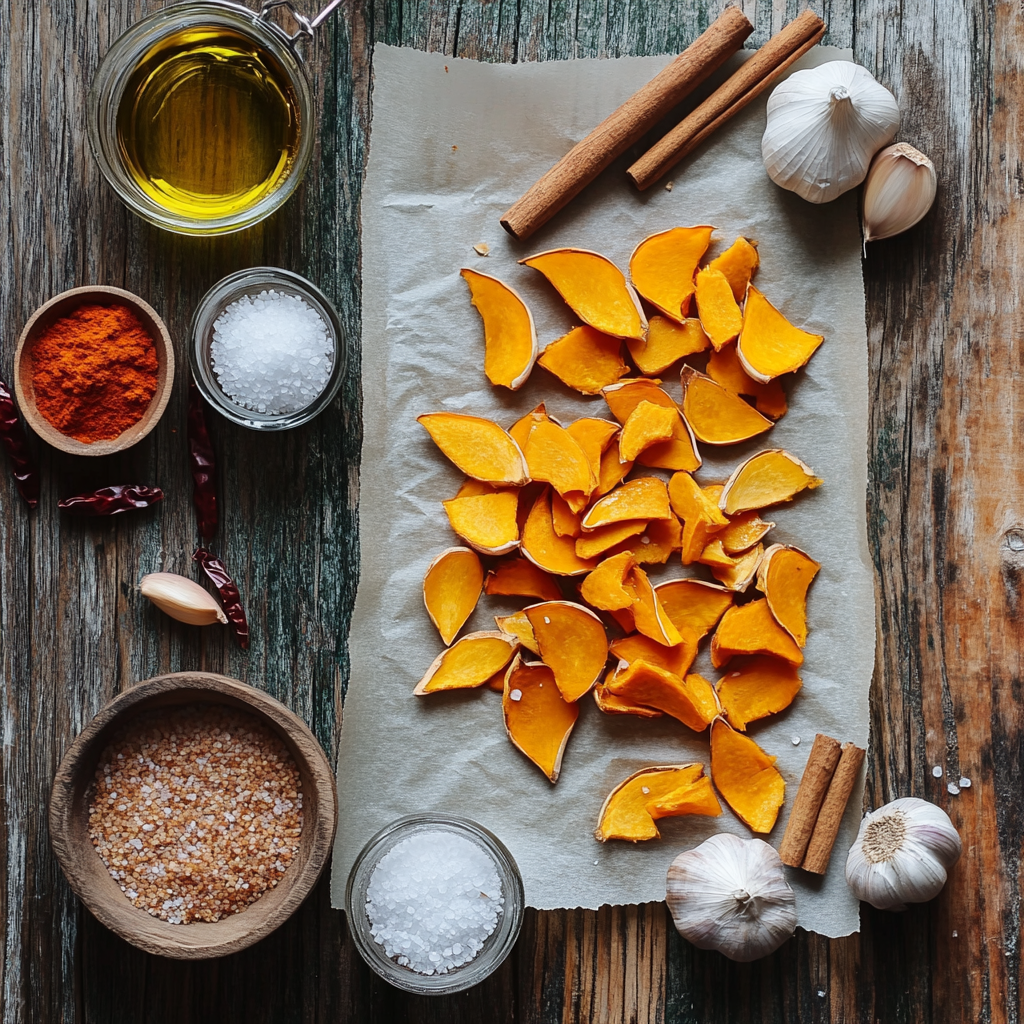
- Roasting with cinnamon sugar or za’atar for a Middle Eastern twist
- Grinding into a nutty meal to add to cookies or muffins
- Blending into pesto or seed butter
- Toasting and sprinkling over gluten-free rice pilaf for a crunchy topper
One of my favorite fall snacks? Maple-roasted squash butternut seeds with flaky sea salt. They’re sweet, savory, and have this cozy, woodsy aroma that reminds me of home. And they last up to 2 weeks in an airtight jar—great for meal prep days.
If you’re looking for more uses, squash butternut seeds also blend well into homemade granola or yogurt bowls. I toss them into vegan desserts as a healthy garnish and a protein boost.
Storage and Meal Prep Tips for Squash Butternut Seeds
The first rule of seed storage? Keep them dry. Whether you’re saving squash butternut seeds to plant later or to eat, make sure there’s no moisture or they’ll spoil quickly.
Here’s how I store mine:
- For planting: Dry completely and place in paper envelopes labeled with the date. Store in a cool, dry place—like a pantry drawer.
- For snacking: Roast, let cool, and store in a sealed glass jar. No fridge needed.
When prepping meals, I roast a batch of squash butternut seeds once a week with different flavors: garlic-herb, cinnamon-honey, or spicy chili lime. This gives me grab-and-go toppings for soups, salads, and even sandwiches. The seeds also work great crushed and added into simplified keto crusts if you’re baking low-carb.
And honestly, involving kids in rinsing and roasting squash butternut seeds is such a sweet memory-making moment. Sprinkle a little cinnamon, give them the bowl to shake, and boom—seed magic!
Do Squash Butternut Seeds Need Soaking Before Planting?
If you’re serious about gardening or just planting a pot or two, soaking squash butternut seeds can make a real difference. While it’s not absolutely required, soaking gives them a head start—especially if your soil is cool or you’re working indoors. I’ve done it both ways in Dubai’s dry heat and Vermont’s cool spring. Trust me, when time is tight, soaking helps.
So, do squash butternut seeds need to be soaked before planting? Technically no, but here’s why many gardeners recommend it.
Soaking Squash Butternut Seeds: Benefits & How-To
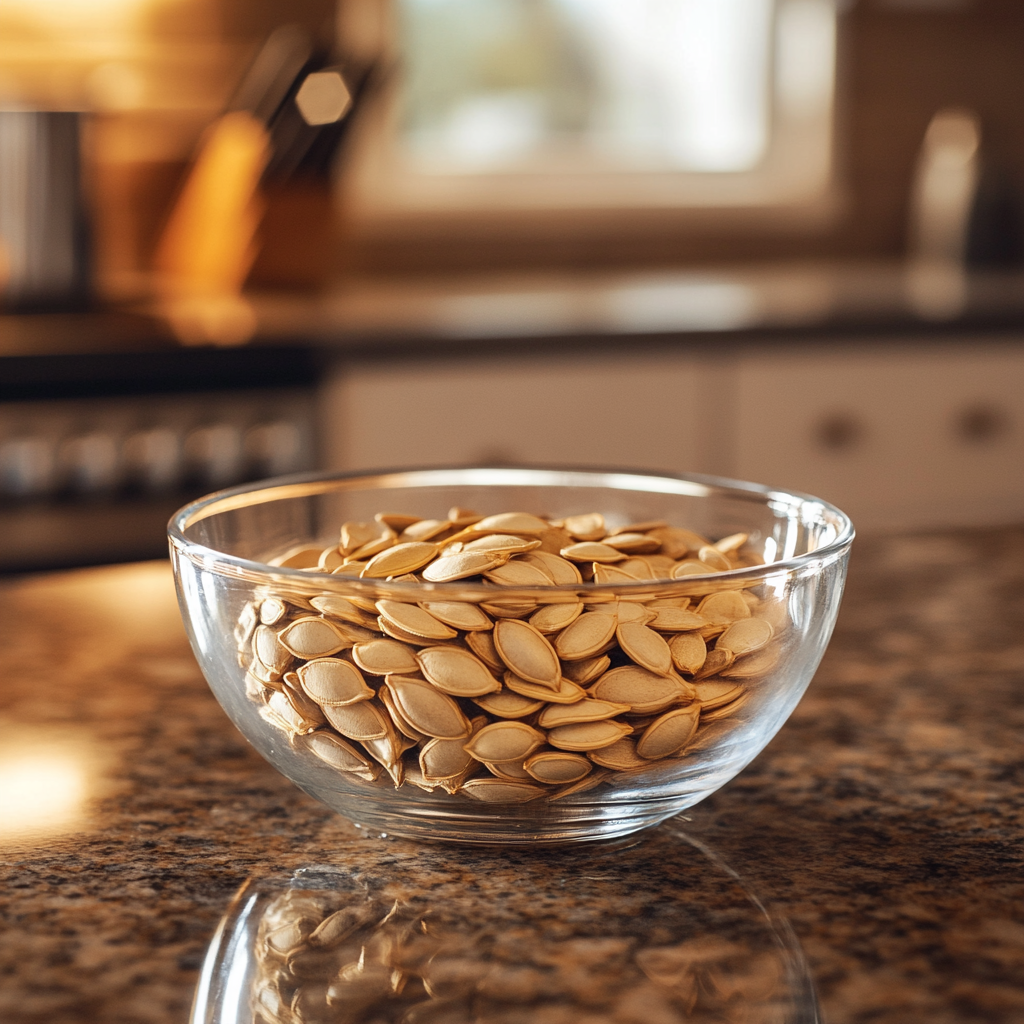
Squash butternut seeds are protected by a hard seed coat. Soaking them softens the shell, allowing moisture to enter faster and promoting quicker germination. This is especially useful if you’re sowing in pots or containers where conditions are less stable.
Here’s how to soak squash butternut seeds:
- Rinse seeds clean and dry them overnight
- Soak them in a container filled with comfortably warm water—not too hot.
- Let them soak for 8 to 12 hours
- Drain and plant immediately in well-draining soil
I’ve noticed soaked squash butternut seeds sprout in as little as 6 days, compared to 10 or more without soaking. If you’re short on time or want a strong germination rate, it’s worth the extra step.
Soaking is also ideal if you’re planting your squash butternut seeds in starter trays indoors. You can later transfer them to a garden or large planter. If your climate is mild, you’ll be amazed how fast they grow. In warm zones like the Gulf, squash butternut seeds thrive even on balconies with the right sun and care.
Looking for something seasonal to serve with your first homegrown harvest? These Greek dessert recipes balance sweet and earthy beautifully alongside roasted squash dishes.
Quick Germination Tips for Squash Butternut Seeds
To get the most from your squash butternut seeds, follow these tips whether you soak them or not:
- Use fresh seeds: Seeds from this season’s squash germinate faster.
- Warmth matters: Soil temps of 70–85°F give the best results.
- Start indoors: Especially in cooler climates or early spring.
- Use compost-rich soil: These seeds love nutrients and consistent moisture.
I even like to plant extra squash butternut seeds just in case—sharing seedlings with neighbors has become a tradition. It’s a beautiful way to spread joy (and vegetables).
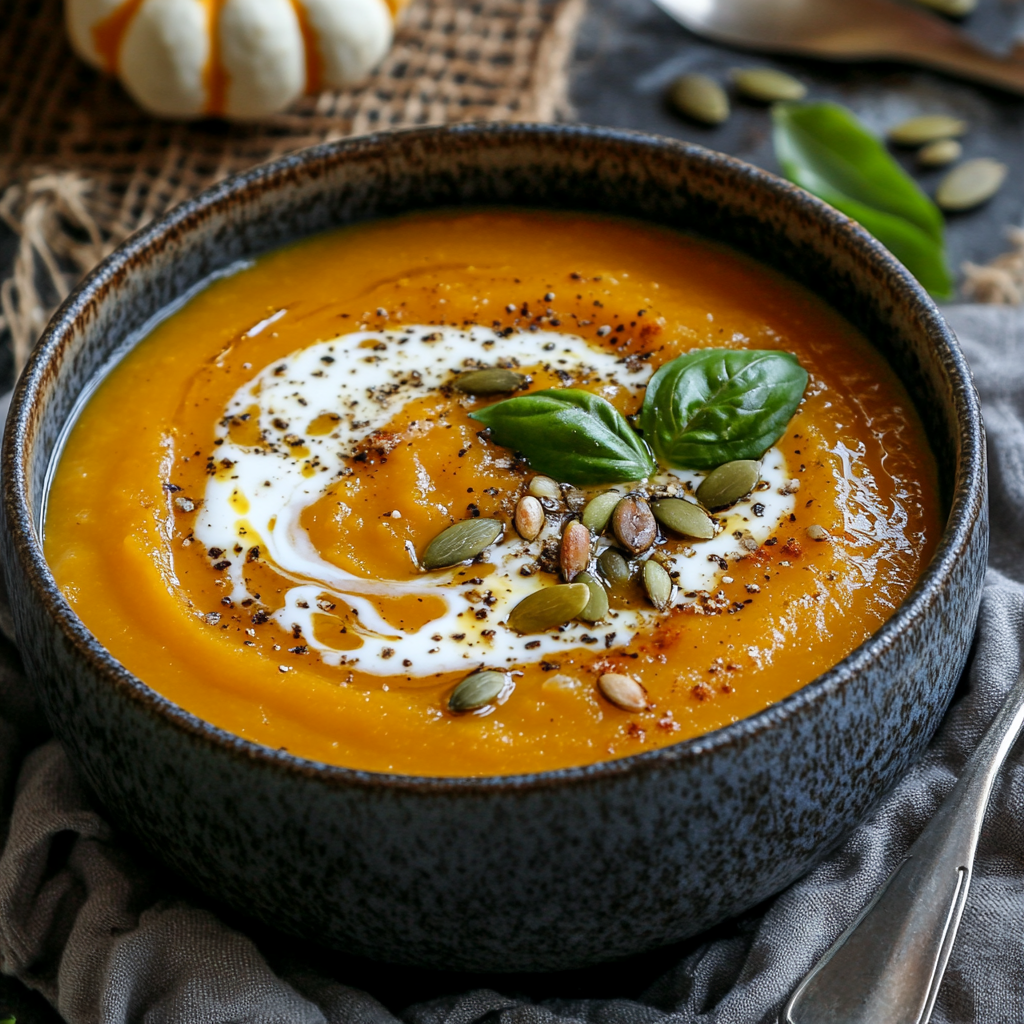
And if you ever find yourself wondering how else to use leftover seeds, revisit this guide or match them with dishes like lemon balm–infused meals that carry the same garden-to-table philosophy.
Frequently Asked Questions About Squash Butternut Seeds
Are you supposed to eat the seeds in butternut squash?
Yes, squash butternut seeds are completely edible and actually packed with nutrients like magnesium, zinc, and plant-based fats. You can roast them, grind them into flour, or even blend them into smoothies or seed butters. Eating squash butternut seeds is not only safe but also delicious when seasoned well.
Can I grow butternut squash from seeds?
Definitely! You can grow full squash vines directly from the squash butternut seeds you scoop out of a ripe fruit. Just dry them completely, soak if preferred, and plant in warm, nutrient-rich soil. Within days, you’ll start seeing green shoots emerge. They’re one of the easiest vegetables to grow for beginners.
What to do with seeds from butternut squash?
Roast them, grind them, plant them, or even make a crunchy topping. There are countless ways to use squash butternut seeds. My favorite? Spicing them with smoked paprika and tossing them into a salad. They’re versatile and store well when dried properly.
Do butternut squash seeds need to be soaked before planting?
Soaking squash butternut seeds is optional but helpful. It softens the seed coat, which speeds up germination. Just let them sit in comfortably warm water for 8 to 12 hours before sowing. Especially in cooler climates or pots, this method can give your seedlings a faster, healthier start.
Conclusion: Why Squash Butternut Seeds Deserve a Place in Your Kitchen and Garden
Squash butternut seeds are one of those little kitchen miracles we often overlook. But now you know—they’re edible, plantable, and packed with goodness. From roasted snack to sprouting vine, these seeds carry a full-circle story of flavor and sustainability. Whether you enjoy them with gluten-free desserts or as a backyard project, squash butternut seeds offer real value.
As someone who started with a handful of seeds on a Vermont windowsill and now grows them on a Dubai terrace, I can tell you: it’s worth saving them. Whether you’re baking, snacking, or planting, these seeds hold more than potential—they hold joy.
If you loved learning about : Squash Butternut Seeds and want more simple wellness tips, real kitchen rituals, and sweet moments that nourish your body and soul—come hang out with me!
💬 Follow me on Facebook for daily tips and behind-the-scenes from my Dubai kitchen.
📌 Join me on Pinterest to save healthy hacks, beautiful recipes, and your favorite dessert boards.
✍️ Read more on Medium for deeper stories, personal reflections, and everything sweet + real.

